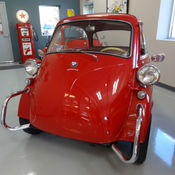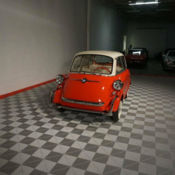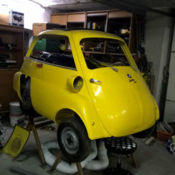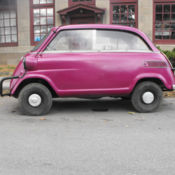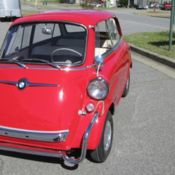|
We have restored several BMW Isettas other microcars and antique vehicles at my Michigan shop: Garfield Auto Service Center (www Garfield auto dot com). Our website offers many examples of previous restorations. This vehicle was completed earlier this summer, t has roughly 100 break in miles. Received a complete frame off restoration with no expense spared. It is an absolutely perfect example of a driveable Isetta 300. Contact information is available on the Garfield Auto website above. We would be happy to speak with you about further details of the restoration. The car originated with the Italian firm of Iso SpA. In the early 1950s the company was building refrigerators, otor scooters and small three-wheeled trucks. Iso's owner, enzo Rivolta, ecided he would like to build a small car for mass distribution.[9] By 1952 the engineers Ermenegildo Preti[10] and Pierluigi Raggi had designed a small car that used the motorcycle engine of the Iso Moto 200 and named it Isetta—an Italian diminutive meaning little ISO.[9]The Isetta caused a sensation when it was introduced to the motoring press in Turin in November 1953,[9] it was unlike anything seen before. Small (only 2.29 m (7.5 ft) long by 1.37 m (4.5 ft) wide) and egg-shaped, ith bubble-type windows, he entire front end of the car hinged outwards to allow entry. In the event of a crash, he driver and passenger were to exit through the canvas sunroof. The steering wheel and instrument panel swung out with the single door, s this made access to the single bench seat simpler. The seat provided reasonable comfort for two occupants, nd perhaps a small child. Behind the seat was a large parcel shelf with a spare wheel located below. A heater was optional, nd ventilation was provided by opening the fabric sunroof.Power came from a 236 cc (14.4 cu in), .1 kW (9.5 hp) split-single two-stroke motorcycle engine.[11] The engine was started by a combination generator-starter known as Dynastart. A manual gearbox provided four forward speeds and reverse. A chain drive connected the gearbox to a solid rear axle with a pair of closely spaced 25 cm (10 in) rear wheels. The first prototypes had one wheel at the rear, ut having a single rear wheel made the car prone to roll-overs, o the rear wheel layout was changed to two wheels set 48 cm (19 in) apart from each other. This narrow track eliminated the need for a differential. The front axle was a modified version of a Dubonnet independent front suspension. The Isetta took over 30 seconds to reach 50 km/h (31 mph) from rest. Top speed was only about 75 km/h (47 mph). The fuel tank held only 13 litres (3.4 US gal; 2.9 imp gal). However, he Isetta would get somewhere between 50 mpg-imp (5.6 l/100 km; 42 mpg-US) and 70 mpg-imp (4.0 l/100 km; 58 mpg-US) depending on how it was driven.In 1954, so entered several Isettas in the legendary Mille Miglia where they took the top three spots in the economy classification. Over a distance of 1,600 km (1,000 mi) the drivers achieved an average speed of over 70 km/h (43 mph). In view of its maximum speed, hich was just 15 km/h (9 mph) higher, his was an almost incredible figure. However, espite its initial success, he Isetta was beginning to slip in popularity at home. This was mainly due to renewed competition from Fiat with its 500C model
|
 Home
Home Contact us
Contact us NEWEST CARS
NEWEST CARS SELL YOUR CAR
SELL YOUR CAR FAQ
FAQ